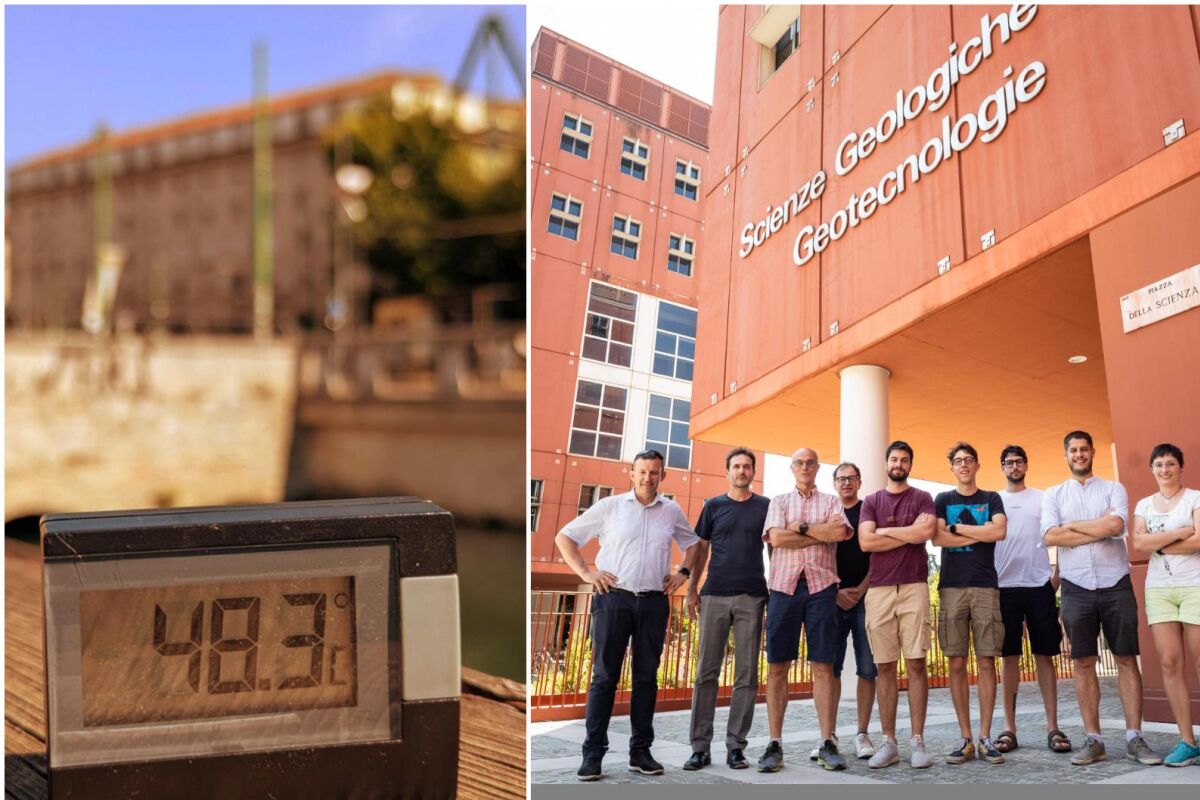The team from the Department of Earth and Environmental Sciences (DISAT), interviewed by the newspaper Il Giorno, analyzes the impact of urban materials on the microclimate: "Differences of even 15 degrees between surfaces. Not only greenery, but also granite and albedo help mitigate the heat."
Piazza della Scienza, in the heart of the University of Milan-Bicocca, has become a true urban laboratory. It’s a regenerated, de-paved, and sensor-equipped space where the microclimate is studied with precision instruments and a scientific approach. The research group from the Department of Earth and Environmental Sciences (DISAT) is responsible for this, involved in the MUSA – Multilayered Urban Sustainability Action project, specifically in Spoke 1, which focuses on environmental sustainability and climate change mitigation in cities.
The team – composed of PhD student Luca Gallia, researcher Alberto Previati, professors Federico Agliardi, Riccardo Castellanza, and Giovanni Crosta, along with technician Stefano Basiricò – was featured in an in-depth article by the newspaper Il Giorno, titled “Heat, off-limits islands in Milan: 48 degrees at Ortomercato, drops to 33 in the park.”
“Satellite images are acquired at 12 PM, with a revisit time of about 16 days,” explains Gallia to Il Giorno. “We can immediately notice the relationship between built-up areas or asphalted areas, more generally the impervious parts, and high surface temperatures.”
The article further states: “We start from Milan – with satellite images – to frame a micro-scale that allows us to concretely understand which elements can affect temperature and cause it to change by a few degrees, even just a few steps away. We are in Piazza della Scienza, recently regenerated and largely de-paved and sensor-equipped: a fiber optic circuit also allows studying subsoil temperatures, and a drone is used to calculate air temperature.”
“‘First, we characterized the square from an environmental point of view thanks to a network for monitoring environmental parameters, mainly air and surface humidity and temperature, using various techniques and instruments,’ continues Gallia. ‘There’s a difference of about 15 degrees between the de-paved part and the paved part. And with these studies, we can characterize the thermal response of materials. Not only vegetation helps mitigate temperatures, but also the choice of one material over another. The albedo of a surface (i.e., the reflective power of a surface, editor’s note) plays a fundamental role.'”
“Thus, different scenarios were compared and models created. For example, it was discovered that on the same summer day in 2024 and in the same 11,000 square meter square, the temperature map is ‘very colorful.’ On the dark slabs of the walkways, temperatures almost reach 50 degrees, on granite – which has a much lighter shade – they are 7 degrees lower, and on the grass, temperatures drop to 34 degrees Celsius. ‘Modeling helps us understand the impact of the square’s regeneration,’ continues the PhD student. ‘To lower ground temperatures, shrubs also matter. For the thermal comfort of citizens, obviously, the shade of plants has a greater influence, even on the perception of heat itself.’ Another aspect revolves around the concept of heat: ‘In the built-up areas, surfaces heat up, remain warm, and emit heat even when the air temperature drops in the evening,’ the PhD student explains. ‘Albedo is useful because it reduces the amount of solar radiation and thus the heat that a material accumulates, by reflecting it. In Piazza della Scienza, this reflective surface has been increased.'”
Researchers are also examining surface temperatures from 2015 to 2024, always between June and August, with temperatures ranging from 40 degrees up to over 50-51 degrees, consistently in the morning. Growth trends and peaks are observed. “‘The maps allow us to visualize areas that differ in microclimate due to their internal characteristics, including types of surfaces, buildings, and vegetation,’ concludes Professor Riccardo Castellanza. ‘From the most critical areas, which require mitigation interventions to slow down the surge in temperatures, to the Parco delle Risaie, where you can even feel a nightly urban breeze.'”





